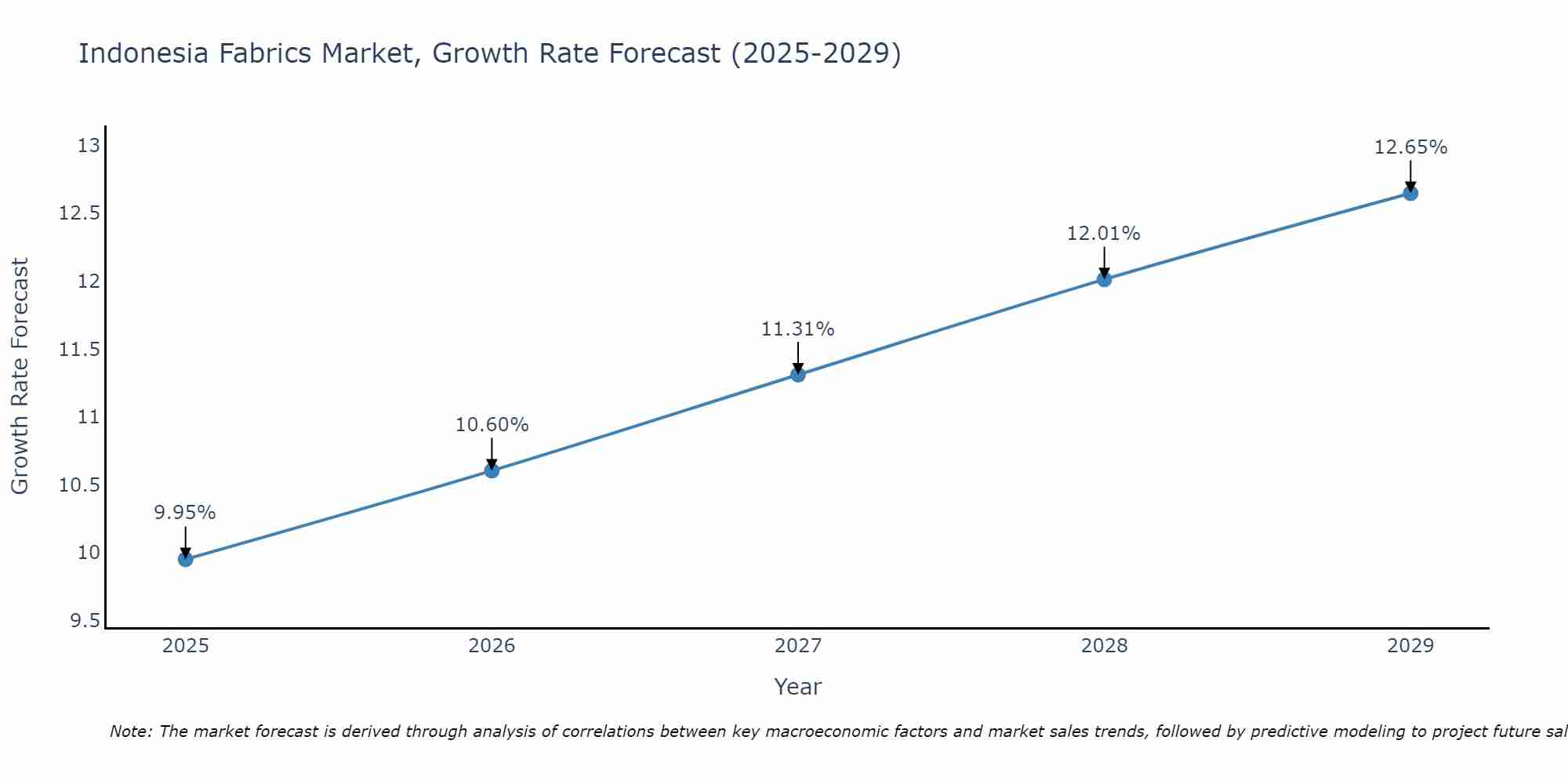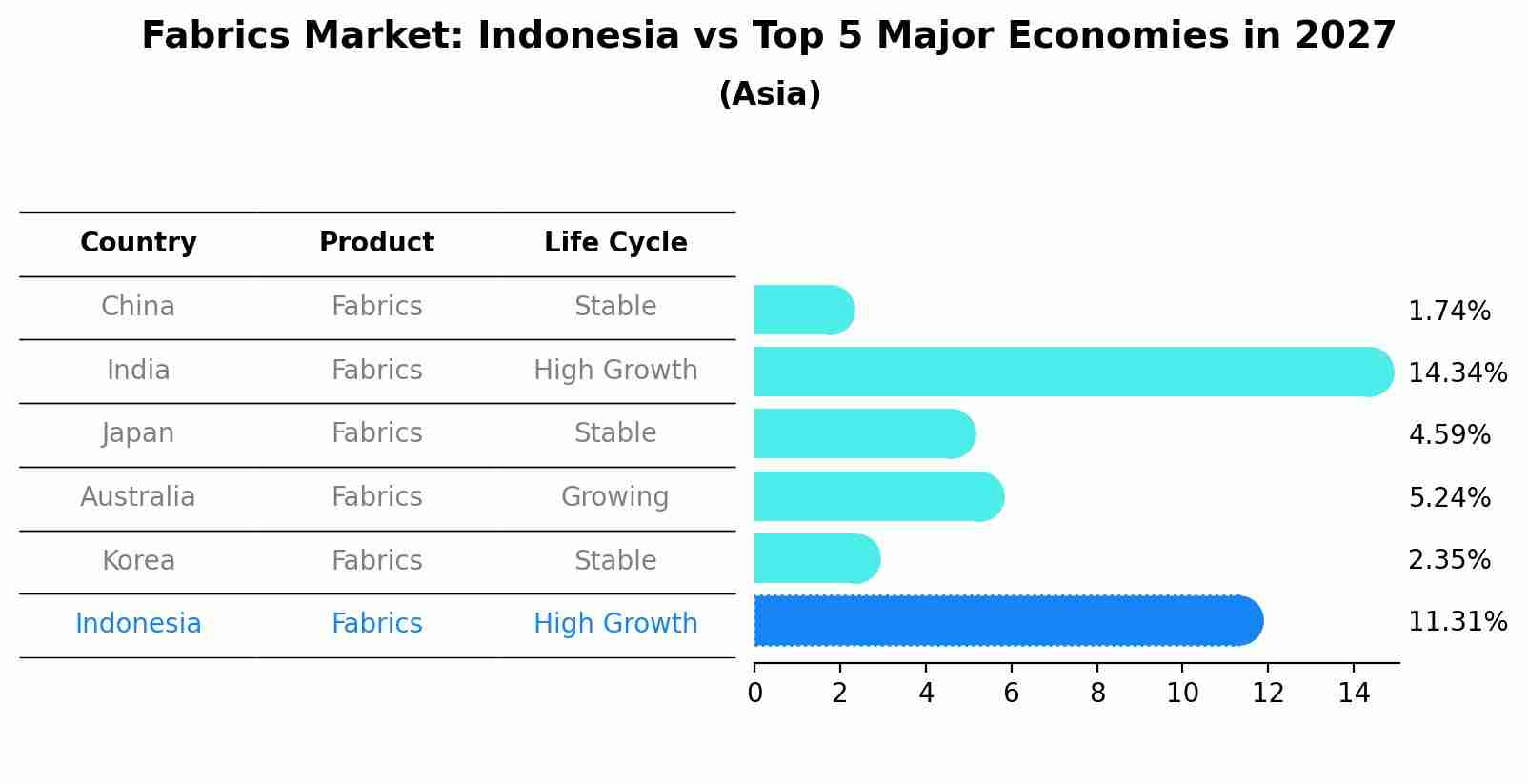Indonesia Fabrics Market (2024-2030) | Outlook, Companies, Trends, Forecast, Growth, Analysis, Industry, Revenue, Value, Size & Share
| Product Code: ETC023628 | Publication Date: Jul 2023 | Updated Date: Apr 2025 | Product Type: Report | |
| Publisher: 6Wresearch | Author: Ravi Bhandari | No. of Pages: 70 | No. of Figures: 35 | No. of Tables: 5 |
Indonesia Fabrics Market Size Growth Rate
The Indonesia Fabrics Market is likely to experience consistent growth rate gains over the period 2025 to 2029. The growth rate starts at 9.95% in 2025 and reaches 12.65% by 2029.

Fabrics Market: Indonesia vs Top 5 Major Economies in 2027 (Asia)
The Fabrics market in Indonesia is projected to grow at a high growth rate of 11.31% by 2027, within the Asia region led by China, along with other countries like India, Japan, Australia and South Korea, collectively shaping a dynamic and evolving market environment driven by innovation and increasing adoption of emerging technologies.

Indonesia Fabrics Market Synopsis
The Indonesia fabrics marketwas d at $7.5 billion in 2020 and is expected to witness a CAGR of 6.4% from 2021 to 2026. Rising population coupled with the growing number of middle-class consumers increasing consumer spending on clothing apparel and rapid urbanization are some of the major factors driving theof the Indonesia fabrics market. The rise in disposable income has enabled people to purchase quality clothes that are manufactured using superior fabrics. This factor is further expected to foster marketover theperiod (2021?2026).
Key Market Players
Some key players operating in Indonesia fabricsinclude PT Unitex Textile Industries; Uni Prima Abadi Texindo; PT Sritex Tbk. CV Sempana Putra Jaya Tekstil; uni polytexindo sentosa tbk.; Bina Kakatua Lestari etc.
Key Highlights of the Report:
- Indonesia Fabrics Market Outlook
- Market Size of Indonesia Fabrics Market, 2023
- Forecast of Indonesia Fabrics Market, 2030
- Historical Data and Forecast of Indonesia Fabrics Revenues & Volume for the Period 2020-2030
- Indonesia Fabrics Market Trend Evolution
- Indonesia Fabrics Market Drivers and Challenges
- Indonesia Fabrics Price Trends
- Indonesia Fabrics Porter's Five Forces
- Indonesia Fabrics Industry Life Cycle
- Historical Data and Forecast of Indonesia Fabrics Market Revenues & Volume By Types for the Period 2020-2030
- Historical Data and Forecast of Indonesia Fabrics Market Revenues & Volume By Manmade And Special Fiber Fabrics for the Period 2020-2030
- Historical Data and Forecast of Indonesia Fabrics Market Revenues & Volume By Knitted Fabrics for the Period 2020-2030
- Historical Data and Forecast of Indonesia Fabrics Market Revenues & Volume By Cotton for the Period 2020-2030
- Historical Data and Forecast of Indonesia Fabrics Market Revenues & Volume By Non-Cotton for the Period 2020-2030
- Historical Data and Forecast of Indonesia Fabrics Market Revenues & Volume By Distribution Channel for the Period 2020-2030
- Historical Data and Forecast of Indonesia Fabrics Market Revenues & Volume By Direct for the Period 2020-2030
- Historical Data and Forecast of Indonesia Fabrics Market Revenues & Volume By Indirect for the Period 2020-2030
- Historical Data and Forecast of Indonesia Fabrics Market Revenues & Volume By Hypermarket/Supermarket for the Period 2020-2030
- Historical Data and Forecast of Indonesia Fabrics Market Revenues & Volume By Specialty Stores for the Period 2020-2030
- Historical Data and Forecast of Indonesia Fabrics Market Revenues & Volume By Online Store for the Period 2020-2030
- Indonesia Fabrics Import Export Trade Statistics
- Market Opportunity Assessment By Types
- Market Opportunity Assessment By Distribution Channel
- Indonesia Fabrics Top Companies Market Share
- Indonesia Fabrics Competitive Benchmarking By Technical and Operational Parameters
- Indonesia Fabrics Company Profiles
- Indonesia Fabrics Key Strategic Recommendations
Frequently Asked Questions About the Market Study (FAQs):
1 Executive Summary |
2 Introduction |
2.1 Key Highlights of the Report |
2.2 Report Description |
2.3 Market Scope & Segmentation |
2.4 Research Methodology |
2.5 Assumptions |
3 Indonesia Fabrics Market Overview |
3.1 Indonesia Country Macro Economic Indicators |
3.2 Indonesia Fabrics Market Revenues & Volume, 2020 & 2030F |
3.3 Indonesia Fabrics Market - Industry Life Cycle |
3.4 Indonesia Fabrics Market - Porter's Five Forces |
3.5 Indonesia Fabrics Market Revenues & Volume Share, By Types, 2020 & 2030F |
3.6 Indonesia Fabrics Market Revenues & Volume Share, By Distribution Channel, 2020 & 2030F |
4 Indonesia Fabrics Market Dynamics |
4.1 Impact Analysis |
4.2 Market Drivers |
4.3 Market Restraints |
5 Indonesia Fabrics Market Trends |
6 Indonesia Fabrics Market, By Types |
6.1 Indonesia Fabrics Market, By Types |
6.1.1 Overview and Analysis |
6.1.2 Indonesia Fabrics Market Revenues & Volume, By Types, 2020-2030F |
6.1.3 Indonesia Fabrics Market Revenues & Volume, By Manmade And Special Fiber Fabrics, 2020-2030F |
6.1.4 Indonesia Fabrics Market Revenues & Volume, By Knitted Fabrics, 2020-2030F |
6.1.5 Indonesia Fabrics Market Revenues & Volume, By Cotton, 2020-2030F |
6.1.6 Indonesia Fabrics Market Revenues & Volume, By Non-Cotton, 2020-2030F |
6.2 Indonesia Fabrics Market, By Distribution Channel |
6.2.1 Overview and Analysis |
6.2.2 Indonesia Fabrics Market Revenues & Volume, By Direct, 2020-2030F |
6.2.3 Indonesia Fabrics Market Revenues & Volume, By Indirect, 2020-2030F |
6.2.4 Indonesia Fabrics Market Revenues & Volume, By Hypermarket/Supermarket, 2020-2030F |
6.2.5 Indonesia Fabrics Market Revenues & Volume, By Specialty Stores, 2020-2030F |
6.2.6 Indonesia Fabrics Market Revenues & Volume, By Online Store, 2020-2030F |
7 Indonesia Fabrics Market Import-Export Trade Statistics |
7.1 Indonesia Fabrics Market Export to Major Countries |
7.2 Indonesia Fabrics Market Imports from Major Countries |
8 Indonesia Fabrics Market Key Performance Indicators |
9 Indonesia Fabrics Market - Opportunity Assessment |
9.1 Indonesia Fabrics Market Opportunity Assessment, By Types, 2020 & 2030F |
9.2 Indonesia Fabrics Market Opportunity Assessment, By Distribution Channel, 2020 & 2030F |
10 Indonesia Fabrics Market - Competitive Landscape |
10.1 Indonesia Fabrics Market Revenue Share, By Companies, 2023 |
10.2 Indonesia Fabrics Market Competitive Benchmarking, By Operating and Technical Parameters |
11 Company Profiles |
12 Recommendations |
13 Disclaimer |
- Single User License$ 1,995
- Department License$ 2,400
- Site License$ 3,120
- Global License$ 3,795
Search
Thought Leadership and Analyst Meet
Our Clients
Related Reports
- Afghanistan Apparel Market (2026-2032) | Growth, Outlook, Industry, Segmentation, Forecast, Size, Companies, Trends, Value, Share, Analysis & Revenue
- Canada Oil and Gas Market (2026-2032) | Share, Segmentation, Value, Industry, Trends, Forecast, Analysis, Size & Revenue, Growth, Competitive Landscape, Outlook, Companies
- Germany Breakfast Food Market (2026-2032) | Industry, Share, Growth, Size, Companies, Value, Analysis, Revenue, Trends, Forecast & Outlook
- Australia Briquette Market (2025-2031) | Growth, Size, Revenue, Forecast, Analysis, Trends, Value, Share, Industry & Companies
- Vietnam System Integrator Market (2025-2031) | Size, Companies, Analysis, Industry, Value, Forecast, Growth, Trends, Revenue & Share
- ASEAN and Thailand Brain Health Supplements Market (2025-2031) | Strategy, Consumer Insights, Analysis, Investment Trends, Opportunities, Growth, Size, Share, Industry, Revenue, Segments, Value, Segmentation, Supply, Forecast, Restraints, Outlook, Competition, Drivers, Trends, Demand, Pricing Analysis, Competitive, Strategic Insights, Companies, Challenges
- ASEAN Bearings Market (2025-2031) | Strategy, Consumer Insights, Analysis, Investment Trends, Opportunities, Growth, Size, Share, Industry, Revenue, Segments, Value, Segmentation, Supply, Forecast, Restraints, Outlook, Competition, Drivers, Trends, Demand, Pricing Analysis, Competitive, Strategic Insights, Companies, Challenges
- Europe Flooring Market (2025-2031) | Outlook, Share, Industry, Trends, Forecast, Companies, Revenue, Size, Analysis, Growth & Value
- Saudi Arabia Manlift Market (2025-2031) | Outlook, Size, Growth, Trends, Companies, Industry, Revenue, Value, Share, Forecast & Analysis
- Uganda Excavator, Crane, and Wheel Loaders Market (2025-2031) | Strategy, Consumer Insights, Analysis, Investment Trends, Opportunities, Growth, Size, Share, Industry, Revenue, Segments, Value, Segmentation, Supply, Forecast, Restraints, Outlook, Competition, Drivers, Trends, Demand, Pricing Analysis, Competitive, Strategic Insights, Companies, Challenges
Industry Events and Analyst Meet
Whitepaper
- Middle East & Africa Commercial Security Market Click here to view more.
- Middle East & Africa Fire Safety Systems & Equipment Market Click here to view more.
- GCC Drone Market Click here to view more.
- Middle East Lighting Fixture Market Click here to view more.
- GCC Physical & Perimeter Security Market Click here to view more.
6WResearch In News
- Doha a strategic location for EV manufacturing hub: IPA Qatar
- Demand for luxury TVs surging in the GCC, says Samsung
- Empowering Growth: The Thriving Journey of Bangladesh’s Cable Industry
- Demand for luxury TVs surging in the GCC, says Samsung
- Video call with a traditional healer? Once unthinkable, it’s now common in South Africa
- Intelligent Buildings To Smooth GCC’s Path To Net Zero


















